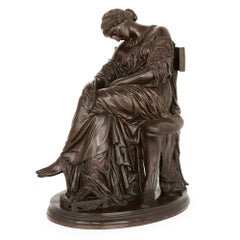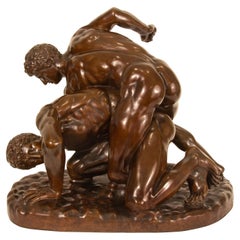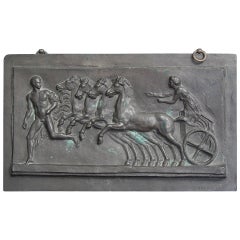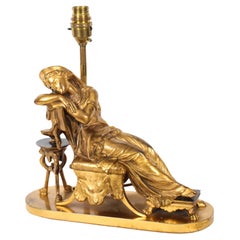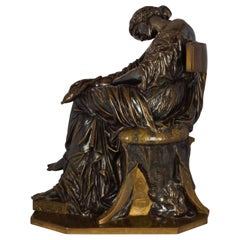Pierre Jules Cavelier
to
1
1
1
1
1
1
1
1
1
1
1
1
11,954
3,896
2,418
2,232
Creator: Pierre-Jules Cavelier
Classical Style Bronze Sculpture of Penelope by Cavelier and Barbedienne
By Pierre-Jules Cavelier, Ferdinand Barbedienne
Located in London, GB
This large patinated bronze antique sculpture depicts the Classical figure Penelope, the wife of Odysseus (Roman name Ulysses) who appears in ...
Category
Late 19th Century French Neoclassical Revival Antique Pierre Jules Cavelier
Materials
Bronze
Related Items
Large Grand Tour Sculpture Bronze Greco-Roman Uffizi Wrestlers Barbedienne
By Ferdinand Barbedienne
Located in Rochester, NY
Large Grand Tour circa 1860s patinated bronze of the Wrestlers. Rich fine dark brown patina. Marked "F. Barbedienne Fondeur." The Wrestlers also known as The Two Wrestlers, The Uffizi Wrestlers or The Pancrastinae...
Category
19th Century Italian Grand Tour Antique Pierre Jules Cavelier
Materials
Bronze
H 18.5 in W 22.5 in D 14 in
"Nude and Horsedrawn Chariot, " Rare Bronze Plaque by Barbedienne
By F. Barbedienne Foundry
Located in Philadelphia, PA
Beautifully modeled, cast and finished, this high-relief plaque of a nude male figure followed by a four-horse chariot driven by a robed female figure was produced the famous Barbedi...
Category
Early 20th Century French Greek Revival Pierre Jules Cavelier
Materials
Bronze
“A la terre!” French Antique Bronze Sculpture by Alfred Boucher & Barbedienne
By F. Barbedienne Foundry, Alfred Boucher
Located in Shippensburg, PA
Bronze sculpture model of "A La Terre!" (1890) after Alfred Boucher
Signed to naturalistic base "A. Boucher", inscribed "F. Barbedienne Fondeur"
Item # 008AMH08W
This powerful mode...
Category
19th Century French Antique Pierre Jules Cavelier
Materials
Bronze
H 26.38 in W 21 in D 13 in
Ferdinand Barbedienne " Diana" Sculpture, 19th Century
By Ferdinand Barbedienne
Located in Madrid, ES
"Diane de Gabies"
French sculpture, late 19th century.
Patinated bronze with "Ferdinand Barbedienne" foundry marks.
Height: 51 cm.
Very goo...
Category
19th Century French Baroque Antique Pierre Jules Cavelier
Materials
Bronze
Barbedienne bronze bust of classical lady on ormolu mounted black marble base.
Located in London, GB
An antique Ferdinand Barbedienne bust of a lady in patinated bronze on a fine ormolu mounted and reeded black marble base. This large bust of a lady is of fine quality and shows off ...
Category
1880s French Antique Pierre Jules Cavelier
Materials
Marble, Bronze
H 26.5 in W 10.25 in D 10.25 in
F. Barbedienne Large Bronze Sculpture of Euterpe
By F. Barbedienne Foundry
Located in Wormelow, Herefordshire
A bronze sculpture of Euterpe attributed to French metalworker Ferdinand Barbedienne (1810-1892). Embellished to the reverse with the official stamp of the Collas et Barbedienne foun...
Category
Mid-19th Century French Neoclassical Antique Pierre Jules Cavelier
Materials
Bronze
"Florentine Singer" Bronze Sculpture by P. Dubois and F. Barbedienne, Circa 1880
By Paul Dubois, Ferdinand Barbedienne
Located in PARIS, FR
Signed P. Dubois 1865 and F. Barbedienne fondeur
Stamped with réduction mécanique Collas
A patinated bronze « Florentine Singer » sculpture, inspir...
Category
1880s French Antique Pierre Jules Cavelier
Materials
Bronze
H 36.62 in W 15.36 in D 10.63 in
A Monumental Patinated Bronze Bust of Jesus Christ by Clesinger and Barbedienne
By Jean-Baptiste Auguste Clesinger, Ferdinand Barbedienne
Located in Queens, NY
A Monumental and Truly Exceptional French Patinated Bronze Bust of Jesus Christ, Circa 1858, Signed J. Clesinger, Rome 1858 & F. Barbedienne Fondeur
This monumental and extraord...
Category
19th Century French Antique Pierre Jules Cavelier
Materials
Bronze
H 26 in W 18 in D 10 in
French 19th Century Patinated Bronze Statue Signed P. Dubois And F. Barbedienne
By Ferdinand Barbedienne
Located in West Palm Beach, FL
An exceptional French 19th century patinated bronze statue signed P. Dubois and F. Barbedienne. The statue entitled Le Courage Militaire, is raise...
Category
19th Century French Antique Pierre Jules Cavelier
Materials
Bronze
H 34 in W 14 in D 16 in
Italian 19th Century Bronze Statue of Apollo, Signed F. Barbedienne Fondeur
By Ferdinand Barbedienne
Located in West Palm Beach, FL
A handsome and high-quality Italian 19th century patinated bronze statue of Apollo, signed F. Barbedienne, Fondeur. The statue is raised by a circular base with a finely detailed tre...
Category
19th Century Italian Antique Pierre Jules Cavelier
Materials
Bronze
H 35.75 in W 22.25 in D 15.25 in
French Bronze Sculpture of "Mercurio Volante" by F. Barbedienne Fondeur, Ca.1850
By F. Barbedienne Foundry
Located in CH
French Bronze Sculpture of "Mercurio Volante"( Mercury Volant) cast and signed by F(erdinand) Barbedienne Fondeur, Ca.1850
After Giambologna (1529–1608)
This finely cast bronze fig...
Category
1850s French Renaissance Revival Antique Pierre Jules Cavelier
Materials
Bronze
H 40.55 in W 19 in D 7.67 in
Bronze Sculpture "Panther of Tunisia" After Antoine-Louis Barye, Barbedienne
By F. Barbedienne Foundry, Antoine-Louis Barye
Located in Shippensburg, PA
ANTOINE-LOUIS BARYE
French, 1796-1875
"Panther of Tunisia no. 2"
Patinated sand-cast bronze signed BARYE in base, signed F. Barbedienne Fondeur to edge of base
Underside incised 2...
Category
19th Century French Romantic Antique Pierre Jules Cavelier
Materials
Bronze
H 4.88 in W 10.24 in D 3.5 in
Previously Available Items
Antique French Ormolu Table Lamp Manner of Pierre-Jules Cavelier 19th Century
By Pierre-Jules Cavelier
Located in London, GB
This is a fine antique ormolu Louis XVI Revival table lamp in the manner of Pierre-Jules Cavelier (French 1814-1894), circa 1890 in date.
The ormolu sculpture is modelled as a classical maiden figure sleeping on a klimos chair...
Category
1890s French Antique Pierre Jules Cavelier
Materials
Bronze, Ormolu
H 11.82 in W 11.82 in D 4.73 in
"Penelope Sleeping" Bronze Sculpture by Pierre Jules Cavelier"
By Pierre-Jules Cavelier
Located in Shippensburg, PA
This is a precious little antique bronze sculpture by Pierre Jules Cavelier, originally exhibited at Salon in 1842 as Femme Grecque Edormie in plaster, was later exhibited in 1849 as...
Category
19th Century French Romantic Antique Pierre Jules Cavelier
Materials
Bronze
Bronze Sculpture of Penelope, French, 19th Century
By F. Barbedienne Foundry, Pierre-Jules Cavelier
Located in London, GB
French, 19th century bronze sculpture of Penelope waiting for Odysseus, probably cast by the Barbedienne foundry to a design by Pierre-Jules Cavalier, stamped to the rear 'J.Cavelier no. 167' and 'Reduction Meccanique'.
This bronze depicts a sleeping Penelope...
Category
Mid-19th Century French Classical Greek Antique Pierre Jules Cavelier
Materials
Bronze
19th Century Silvered French Bronze Sculpture "Penelope" by Pierre Cavelier
By F. Barbedienne Foundry, Pierre-Jules Cavelier
Located in Shippensburg, PA
This is a precious little antique bronze sculpture by Pierre Jules Cavelier, originally exhibited at Salon in 1842 as Femme Grecque Edormie in plaster, was later exhibited in 1849 as a marble sculpture under the title of Penelope. It was cast almost exclusively by the foundry of Ferdinand Barbedienne and is the only Cavelier sculpture to appear in their 1886 catalog in five reductions after the original. His works are quite scarce, only two sculptures being catalogued in Berman's extensive reference work (vol. III). The sculpture is a highly detailed sand cast example, expertly tooled and finished with a silver patina set against a rubbed bronze accent in the base and chair. The side of the seat is impressed with a seal typical of Cavelier, noting it as number 258.
Pierre Jules Cavelier was born in August of 1814 and studied under both P. Delaroche and David D'Angers at the Ecole des Beaux-Arts after his entry in 1831. In 1836 he won second prize at the Prix de Rome for his model of Death of Socrates and with his sculpture of Diomedes Removing the Image of the Goddes Pallas Athene...
Category
1880s French Romantic Antique Pierre Jules Cavelier
Materials
Marble, Bronze, Steel
H 13.5 in W 11 in D 8.5 in
Pierre Jules Cavelier Bronze Sculpture of Penelope by F. Barbedienne
By Pierre-Jules Cavelier, F. Barbedienne Foundry
Located in Shippensburg, PA
PIERRE JULES CAVELIER (FRENCH, 1814-94) BRONZE SCULPTURE OF A SLEEPING WOMAN
"Penelope", cast by F. Barbedienne Fondeurs, sealed verso "729 J Cavelier" with A. Collas reduction seal
Item # 503DIP07
This is a precious little antique bronze sculpture by Pierre Jules Cavelier, originally exhibited at Salon in 1842 as Femme Grecque Edormie in plaster, was later exhibited in 1849 as a marble sculpture under the title of Penelope. It was cast almost exclusively by the foundry of Ferdinand Barbedienne and is the only Cavelier sculpture to appear in their 1886 catalog in five reductions after the original. This cast is La reduction no. 4, originally offered at 200 francs with a height of 25 cm. His works are quite scarce, only two sculptures being catalogued in Berman's extensive reference work (vol. III). The sculpture is a highly detailed sand cast example, expertly tooled and finished with a brown patina. The details throughout are finely chiseled, the back of the seat being impressed with a seal typical of Cavelier. Beneath the sculpture, across the bronze stretcher, are ink inscriptions of "48531" with another faded and somewhat illegible inscription; beneath the bar is an impression of "C.77E75". For the serious collector of Romantic period bronze sculptures, this is a finely detailed and well preserved acquisition.
Pierre Jules Cavelier was born in August of 1814 and studied under both P. Delaroche and David D'Angers at the Ecole des Beaux-Arts after his entry in 1831. In 1836 he won second prize at the Prix de Rome for his model of Death of Socrates and with his sculpture of Diomedes Removing the Image of the Goddes Pallas Athene...
Category
Late 19th Century French Romantic Antique Pierre Jules Cavelier
Materials
Bronze
Small Barbedienne French Bronze Sculpture of Penelope by Pierre Cavelier
By Pierre-Jules Cavelier, F. Barbedienne Foundry
Located in Shippensburg, PA
PIERRE JULES CAVELIER (FRENCH, 1814-94) ANTIQUE BRONZE SCULPTURE "PENELOPE", CAST BY F. BARBEDIENNE
Impressed "J. Cavelier 887" w/ the A. Collas reduction seal and inscription in the base of "432 F. Barbedienne Fondeurs", c. 1860-80
This is a precious little work by Pierre Jules Cavelier, originally exhibited at Salon in 1842 as Femme Grecque Edormie in plaster, later as marble in 1849 under the title of Penelope. It was cast almost exclusively by the foundry of Ferdinand Barbedienne and is the only Cavelier sculpture to appear in their 1886 catalog in five reductions after the original. This cast is La reduction no. 5, originally offered at 125 francs with a height of 16 cm. His works are very scarce, only two sculptures being catalogued in Berman's extensive reference work (vol. III). The present example is particularly delightful for it's stunning patina, the deep red with hints of black and browns, specks of black and traces of gold. It is absolutely stunning. Moreover, particularly surprising is the level of detail in a work of such diminutive proportions - a very high level of skill is demanded to cast a work this small with this level of utter perfection, the tooling of the clothing and stool executed with the precision of a jeweler. It is exquisitely preserved with only the most minor of patina wear.
Pierre Jules Cavelier was born in August of 1814 and studied under both P. Delaroche and David D'Angers at the Ecole des Beaux-Arts after his entry in 1831. In 1836 he won second prize at the Prix de Rome for his model of Death of Socrates and with his sculpture of Diomedes Removing the Image of the Goddes Pallas...
Category
19th Century French Antique Pierre Jules Cavelier
Materials
Bronze
Pierre-jules Cavelier furniture for sale on 1stDibs.
Pierre-Jules Cavelier furniture are available for sale on 1stDibs. These distinctive items are frequently made of metal and are designed with extraordinary care. There are many options to choose from in our collection of Pierre-Jules Cavelier furniture, although gold editions of this piece are particularly popular. If you’re looking for additional options, many customers also consider furniture by Alfred Boucher, Antonio Canova, and Thiebaut Freres. Prices for Pierre-Jules Cavelier furniture can differ depending upon size, time period and other attributes — on 1stDibs, these items begin at $68,131 and can go as high as $68,131, while a piece like these, on average, fetch $68,131.
